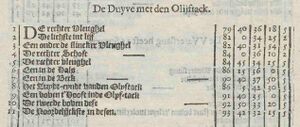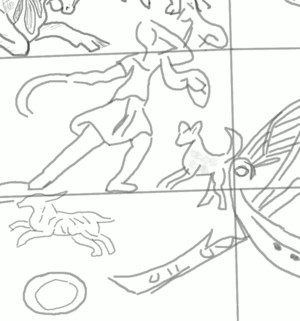Columba
One of the 88 IAU constellations. The constellation was created by Dutch sailors in the 1590s.
Etymology and History
Origin of Constellation
The stars that form the constellation of the Dove have been listed in star catalogues since ancient times. However, they are not named in the Almagest and do not belong to any constellation. Ptolemy lists them in the vicinity of the constellation of the Great Dog, but does not consider them to belong to its figure. He has a separate subheading in his catalogue for such cases.
This was not changed until the 16th century: The Dutch cartographer Petrus Plancius formed the figure of the Dove from these eight ‘free’ stars. This bird is therefore next to the aft deck of the ship, which begins next to the back of the Great Dog. The constellation is first depicted on the globe of 1596. For Plancius, the ship is not the Greek Argo, but Noah's Ark. According to the biblical story, the dove announcing to Noah that the flood was receding should be located next to it - a Christian symbol of hope and the end of the catastrophe.
Ancient Globes
The Mainz Globe and the Kugel Globe both show a ring of stars at the position of Columba. This might be a symbol for a group of unnamed scattered stars in the area.
Almagest
| Οἱ περὶ τὸν Κύνα ἀμόρφωτοι. | Stars round Canis Major outside the constellation: | ||
|---|---|---|---|
| 19 | ὁ ἀπ’ ἄρκτου τῆς κορυφῆς τοῦ Κυνός. | The star to the north of the top of The Dog | 22 Mon |
| 20 | τῶν ὑπὸ τοὺς ὀπισθίους πόδας ὡς ἐπ’ εὐθείας ὁ ὁ νοτιώτατος. | The southernmost ofthe 4 stars almost on a straight line under the hind legs | θ Col |
| 21 | ὁ τούτου βορειότερος. | The one north of this | κ Col |
| 22 | ὁ ἔτι τούτου βορειότερος. | The one north again of this | δ Col |
| 23 | ὁ λοιπὸς καὶ βορειότερος τῶν δ | The last and northernmost of the 4 | λ CMa |
| 24 | τῶν πρὸς δυσμὰς τοῦς τέσσαρσιη ὡς ἐπ’ εὐθείας γ ὁ προἠγούμενος | The most advanced ofthe 3 stars almost on a straightline to the west of the [ above] four | μ Col |
| 25 | ὁ μέσος αὐτῶν | The middle one | λ Col |
| 26 | ὁ ἑπόμευος τῶν τριῶν. | The rearmost of the three | γ Col |
| 27 | τῶν ὑπὸ τούτους β λαμπρῶν ὁ ἐπόμευος. | The rearmost of the 2 bright stars under these | β Col |
| 28 | ὁ προηγούμενος αὐτῶν. | The more advanced of them | α Col |
| 29 | ὁ λοιπὸς καὶ νοτιώτερος τῶν προειρημένων. | The last star, to the south of the above | ε Col |
Transfer and Transformation of the Constellation
Mythology
After Plancius had renamed the old constellation of the ship in Christian terms and it was no longer called Argo, but Noah's Ark, he also understood the dove in biblical terms. When the flood had been going on for a long time, Noah regularly sent out a dove. One day it returned with an olive branch, signalling to Noah that the flood was about to recede. There is a similar story of the dove as an encouragement in Greek mythology:
Supposedly, on or in the Bosperus, the passage between the Mediterranean and the Black Sea, there were once two floating or swinging rocks. They moved towards each other and crushed everything that tried to pass through the Bosperus. When Jason set off on his journey through this strait with the Argo, he sent a dove between the rocks. The bird only lost one tail feather, but returned safely. The Argonauts then also managed to steer their ship between the mystical, restless rocks - the Symplegades. After that and ever since, they have remained still.



